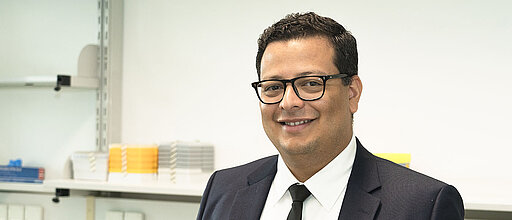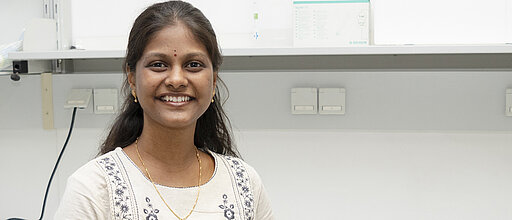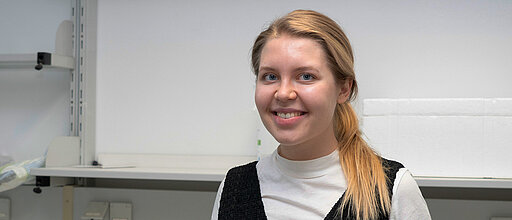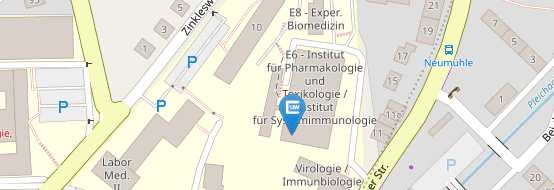Das Talavera-López-Labor untersucht die Mechanismen der Homöostase, Entzündung und Infektion in verschiedenen Organen und Spezies mithilfe von räumlich aufgelösten Einzelzelltechnologien und Methoden der Computerbiologie, einschließlich maschinellem Lernen und KI. Unser kombinierter Ansatz ermöglicht es uns zu verstehen, wie zelluläre Prozesse in jedem Organ funktionieren, um die Homöostase aufrechtzuerhalten, und wie sich Zellen während der gesamten Lebensspanne eines Organismus an verschiedene Herausforderungen anpassen.
Computational Immunobiology (Talavera-López Lab)
Forschung
We use cutting-edge spatially-resolved single-cell multiomics and computational biology to identify and characterise stromal-myeloid niches in tissue repair across different organs and systems. The overarching goal is to elucidate the circuits of gene regulation, metabolism and cell-cell communication between different cellular effectors, uncovering their collaborative roles in tissue homeostasis, repair, and regeneration. We combine gene expression and chromatin accessibility to profile stromal and myeloid cells at single-cell resolution. We use deep learning methods to link these circuits and map them in situ with spatial biology technologies to construct detailed cellular circuits and identify key regulatory nodes. Following our previous work on the human heart (Talavera-López, 2020 & Kanemaru, 2023), we aim to expand the characterisation of cellular systems across other organs, species and different developmental stages.
Furthermore, we leverage our clinical and computational expertise to integrate our work at the cellular level into the clinic. Using deep learning, we integrate cellular circuits with more accessible data modalities such as clinical laboratory tests and electronic health records. This eclectic approach allows us to bridge the gap between cellular behaviour and clinical trajectories to identify biomarkers for early diagnosis and help develop innovative therapeutic interventions.
Our primary objective is to decode the intricate interplay of cell-to-cell communication and metabolism that governs organismal development. We employ spatially-resolved single-cell multiomics to create comprehensive, high-resolution maps of cellular interactions throughout developmental stages. Using spatial biology, our work seeks to capture the dynamic state of individual cells, offering unparalleled insights into their interactions, differentiation, and adaptive cellular behaviour during development. Using explainable AI, we build on prior knowledge to understand the patterns of cell-cell interactions that give rise to individual organs, providing a novel perspective on cellular adaptive behaviours and evolutionary potential across multiple species.
This exploration carries substantial clinical implications. As we gain insights into tissue repair mechanisms, we aim to translate our findings into novel therapeutic strategies for regenerative medicine.
Our research is dedicated to decoding the host-pathogen dynamic during infection. We delve into the host's cellular circuitry and the pathogen's genomic adaptations to grasp the intricacies of disease progression. Using Natural Language Processing (NLP) methods and genomics, we explore how pathogens manipulate their genome to generate virulence factors and evade the immune system (Talavera-López, 2019, Talavera-López 2021 & Talavera-López 2022). On the host side, we use spatial and single-cell biology to characterise the niches interacting with the pathogen in situ (Sungnak, 2020). This approach enables a comprehensive perspective highlighting dynamic responses during infection. Importantly, we emphasise using explainable AI (xAI), ensuring the results are interpretable and allowing researchers to link the model results with prior knowledge to facilitate the clinical translation of our findings. Moreover, using xAI, we aim to construct reliable patient trajectories during acute infection, potentially highlighting novel tools for early diagnosis. Our work contributes significantly to understanding disease pathogenesis and informs the development of personalised therapies for infectious diseases.
Talavera López link pubmed: https://pubmed.ncbi.nlm.nih.gov
Selected Articles:
Understanding how genome plasticity helps with organism adaptability:
- Microevolution of Trypanosoma cruzi reveals hybridization and clonal mechanism driving rapid genome diversification. Matos GM, Lewis MD, Talavera-López C et al., eLif 2022 May 10 ; doi: 10.7554/eLife.75237
- Repeat-driven generation of antigenic diversity in a major human pathogen, Trypanosoma cruzi. Talavera-López C, Messenger L, Lewis MD et al., Front. Cell Infect. Microbiol. 2021 March 03 ; doi: 10.3389/fcimb.2021.614665
- Reading and editing of the Pleurodeles waltl genome reveals novel features of tetrapod regeneration. Elewa A, Wang H, Talavera-López C et al., Nature Communications. 2017 Dec 22 ; doi: 10.1038/s41467-017-01964-9
- Genome of the avirulent human - infective trypanosome - Trypanosoma rangeli. Stocco P, Wagner G, Talavera-López C et al., PLoS Negl. Trop. Dis. 2014 Sept 18 ; doi: 10.1371/journal.pntd.0003176
- The Norway spruce genome sequence and conifer evolution. Nysted B et al., Nature 2013, May 22; doi: 10.1038/nature12211; Epub 2013 May 22
Applying Artificial Intelligence and single-cell technologies to answer biological questions:
- Comparison of whole blood and spleen transcriptional signatures over the course of an experimental malaria infection. Talavera-López C, Bediako Y, Lin J et al. Scientific Reports. 2019, November 1; doi: 10.1038/s41598-019-52388-y
- Transcriptomic profiling of microglia reveals signatures of cell activation and immune response, during experimental cerebral malaria. Capuccini B, Lin J, Talavera-Lopez C et al. Scientific Reports. 2016, December 19; doi:10.1038/srep39258
Understanding cellular circuits in health and disease:
- Spatially resolved multiomics of human cardiac niches. Kanemaru K, Cranley J, Muraro D, et al. Nature. 2023, July 12; doi: 10.1038/s41586-023-06311-1
- A python library for probabilistic analysis of single cell omics data. Gayoso A, López R, Xing G et al. Nature Biotechnology. 2022, February 07; doi: 10.1038/s41587-021-01206-w
- User-friendly, scalable tools and workflows for single cell RNA seq analysis. Moreno P, Huang N, Manning J et al. Nature Methods. 2021, March 29; doi: 10.1038/s41592-021-01102-w
- Single-cell meta-analysis of SARS-CoV-2 entry genes across tissues and demographics. Muus C, Luecken M, Eraslan G et al. Nature Medicine. 2021, March 02; doi: 10.1038/s41591-020-01227-z
- Expression atlas update: from tissues to single cells. Papatheodorou I, Moreno P, Manning J et al. Nucleic Acids Res. 2020, October 30; doi: 10.1093/nar/gkz947
- Cells of the adult human heart. Talavera-López C et al Nature. 2020, September 24; doi: 10.1038/s41586-020-2797-4
- SARS-CoV-2 entry factors are highly expressed in nasal epithelial cells together with innate immune genes. Sungnak W, Huang N, Becavin C, Berg M, Queen R, Litvinuková M, Talavera-López C et al Nature Medicine. 2020, April 23; doi: 10.1038/s41591-020-0868-6
- A cellular census of human lungs identifies novel cell states in health and in asthma. Vieira Braga F, Kar G, Berg M et al. Nature Medicine. 2019, June 17; doi: 10.1038/s41591-019-0468-5
Applying Artificial Intelligence and single-cell technologies to answer biological questions:
- An integrated cell atlas of the human lung in health and disease. Sikkema L, Strobl D, Zappia L, et al. Nature Medicine. 2023, June 08 ; doi: 10.1038/s41591-023-02327-2
- Biologically informed deep learning to query gene programmes in single-cell atlases. Lotfollahi M, Rybakov S, Hrovatin K, et al. Nature Cell Biology 2023, February 02; doi: 10.1038/s41556-022-01072-x
Prof. Dr. Carlos Talavera-López

Christian Eger
Srivalli Kolla

Anna Maguza



